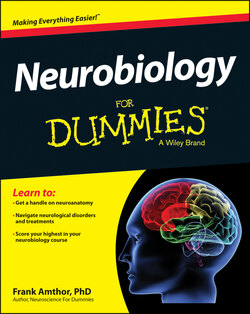Читать книгу Neurobiology For Dummies - Frank Amthor - Страница 29
Basal ganglia, cerebellum, motor and premotor cortex, and thalamus
ОглавлениеChapter 8 takes up the basal ganglia, major controllers of behavior. The major basal ganglia nuclei include the caudate and putamen, which together make up the input region called the striatum. The globus pallidus is the major basal ganglia output to the motor portion of the thalamus, which projects and receives input from motor areas in the frontal lobe. The basal ganglia nuclei interact extensively with the substantia nigra in the midbrain, and the subthalamic nucleus.
The cerebellum is a motor learning and coordination center. It receives sensory input from spinal sensory neurons and cranial nerves of the vestibular and visual systems. Its major output is to motor thalamus that projects to frontal motor cortex. The cerebellum is necessary for learning coordinated, well-timed movements. It operates as a feed-forward controller that generates error signals used to reprogram motor areas such as premotor cortex to generate appropriate limb movements.
Two frontal areas just anterior to primary motor cortex, the supplementary motor area (SMA) and premotor cortex (PMC), contain motor programs that command and coordinate multi-limb movements to accomplish goals. One main difference between these two areas is that motor programs in SMA tend to be those that we can learn to do with little sensory feedback, such as typing. PMC control tends to occur when sequences are being learned, and depends more on peripheral feedback and cerebellar error signals.
The thalamus is often called the gateway to the neocortex, since all senses — except for some of olfaction (the sense of smell) — relay through it. But the neocortex projects back extensively to the thalamus. These back projections come from “higher” cortical areas, as well as from the primary areas that receive inputs from that area of the thalamus.
The gateway metaphor for the thalamus implicitly makes the neocortex the real seat of neural control and computation. The thalamus is the modulator of transmission to the cortex, emphasizing some pathways at the expense of others as a mediator of attention. A different metaphor for thalamic-cortical interactions is that the thalamus is running the “main” program, which makes “subroutine” calls to the neocortex for some detailed neural computations. This makes processing in the thalamus the primary controller of brain activity, including consciousness (see Chapter 14). Activity in the neocortex becomes the content of that consciousness. It’s too early to say whether this subroutine metaphor will be as useful as the gateway metaphor has been.
